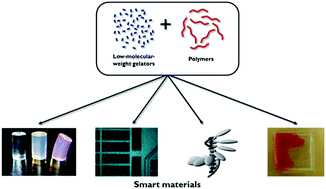Expanding the scope of gels – combining polymers with low-molecular-weight gelators to yield modified self-assembling smart materials with high-tech applications
Abstract
Combining low molecular weight gelators (LMWGs) with polymers is a broad yet relatively recent field, in a phase of rapid expansion and with huge potential for exploitation. This review provides an overview of the state-of-the-art and reflects on new technologies that might be unlocked. We divide LMWG–polymer systems into five categories: (i) polymerisation of self-assembled LMWG fibres, (ii) capture of LMWG fibres in a polymer matrix, (iii) addition of non-gelling polymer solutions to LMWGs, (iv) systems with directed interactions between polymers and LMWGs, and (v) hybrid gels containing both LMWGs and polymer gels (PGs). Polymers can have significant impacts on the nanoscale morphology and materials performance of LMWGs, and conversely LMWGs can have a major effect on the rheological properties of polymers. By combining different types of gelation system, it is possible to harness the advantages of both LMWGs and PGs, whilst avoiding their drawbacks. Combining LMWG and polymer technologies enhances materials performance which is useful in traditional applications, but it may also yield major steps forward in high-tech areas including environmental remediation, drug delivery, microfluidics and tissue engineering.


 Please wait while we load your content...
Please wait while we load your content...